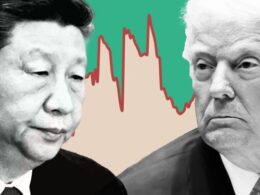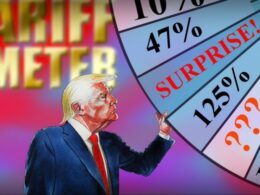Unlock the Editor’s Digest for free
Roula Khalaf, Editor of the FT, selects her favourite stories in this weekly newsletter.
Good morning. Walmart’s CEO warned yesterday that tariffs would force it to raise prices this year — even after the recent decrease in duties on China. The retail giant said last quarter that it did not know how much tariffs would affect the core business. It appears to know more now, and the news is not good for consumers. Email us: robert.armstrong@ft.com, aiden.reiter@ft.com and hakyung.kim@ft.com.
Gold
The other day on the Unhedged podcast, I speculated that perhaps gold, which hit the astonishing level of $3,250 a few weeks ago and has drifted sideways ever since, might have put in its long-term high. My reasoning for this is embarrassingly simple: we’ve reached peak tariff anxiety — and perhaps peak Trump anxiety — and the price is already really high.
My colleague Toby Nangle heard the podcast and sent along this chart from the latest Bank of America Global Fund Manager Survey:
The highest-ever proportion of managers in the survey think gold is overvalued — almost 50 per cent (light blue columns). But that’s not the interesting bit. The interesting bit is that the last two times a lot of managers agreed that gold was overvalued, in 2020 and in 2011, they were right. Look at how gold performed subsequently (dark blue line). After 2011’s fall, it took a decade for gold to retake its high in nominal terms.
Usually, when you ask a bunch of investors whether something is under- or overvalued, and a bunch of them agree, the thing to do is run the other way. A deep consensus can only do two things for an asset’s price. It can stay like it is (no price movement) or it can reverse (price goes against the old consensus). There just aren’t very many people outside of the main view left to convert, which causes the consensus to cave in on itself — rewarding those who went against the grain. Investor sentiment has actually tended to be right with gold, however, and I don’t know why.
Hamad Hussain of Capital Economics agrees that consensus may be right this time, too, and gold could be rangebound for a while. He notes that the last two big rallies (1976-1982, 2008-2012) lasted three to four years, and by that standard this one is starting to age. And his team expects the dollar to rebound in the medium term, which would be a headwind. He also points out that gold ETF inflows — which, in a break with history, have not been a big contributor to this rally — are now rising. The key marginal buyers in the rally have been institutional buyers, especially in Asia, as well as central banks. But ETF buyers are mostly financial buyers in the west, who are sensitive to things such as dollar strength and real US interest rates. If financial buyers are in charge, those factors will assert themselves again, potentially to gold’s detriment. Here is Hussain’s quite dramatic chart:

The gold price is hard to understand, but it always seems to be saying something interesting.
Inflation expectations
A month ago we observed that while long-term inflation expectations were stable and not contributing much to rising bond yields, short-term inflation expectations (as measured by inflation swaps) were rising fast. Tariff worries appeared to be translating into expectations of a short burst of inflation, but not sustained price rises. Markets may have expected tariff-induced inflation to be transitory, or an inflation-killing growth slowdown, or both.
That trend has reversed — in part. Longer-term inflation expectations (pink and light blue lines) have been ticking up since mid-April, and short-term expectations (dark blue line) for inflation fell dramatically after the Trump administration reined in the tariffs on China:

It’s clear that the prospect of lower tariffs on China — whose cheap goods help keep US prices down — is causing markets to downgrade their short-term price expectations. Good. The increase in longer-term expectations is also good, at least to the extent it reflects better growth expectations. The US economy is still quite strong, and without the tariff dampener, it could stay that way. Stagflation seems to be coming off the table.
But this also raises questions for the market and, crucially, the Federal Reserve. Back in April, we were rather concerned about short-term inflation. Now that fear is shifting to the long term. As the Fed constantly points out, a key metric in its rate decision is long-term inflation expectations. If they are in check, the Fed has more flexibility to lower rates. If longer-term inflation expectations continue rising — creeping towards 3 per cent — the Fed may have to keep rates higher for longer, even if there is weakness in the labour market.
And there is reason to think they will continue rising. Long-term inflation expectations are around where they were right before “liberation day” — but tariffs are much higher today than on April 1 (a 30 per cent tariff on China will still be felt, as Walmart has just pointed out). It’s possible that before “liberation day” the market expected even worse; Trump did float 10 per cent global tariffs, and 60 per cent on China during the campaign. The market may have also bought into the “Taco” trade, and thinks tariffs will soon be lower still. Yet, if the 30 per cent is locked in for the long term, inflationary pressures could rise all across the curve. And we already were on a rising trend:

Notice the step change after Covid-19. This is what the Fed has been fighting against for nearly three years now: higher inflation expectations, as a result of strong growth and the jump in prices in 2022. The bond market thinks we are still in a higher-inflation regime, potentially for the long haul.
The bond market doesn’t know anything the rest of us don’t. It won’t form a firm opinion about the inflation outlook until tariff policy becomes clear. If it ever does.
(Reiter)
One good read
FT Unhedged podcast

Can’t get enough of Unhedged? Listen to our new podcast, for a 15-minute dive into the latest markets news and financial headlines, twice a week. Catch up on past editions of the newsletter here.
Source link









